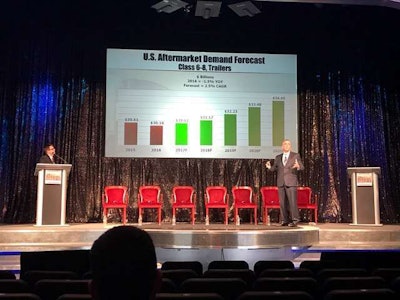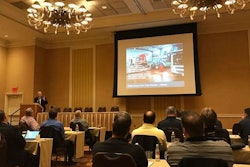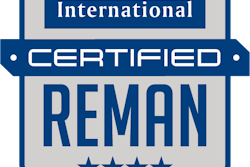 David Kalvelage and John Blodgett of MacKay & Company present during Heavy Duty Aftermarket Dialogue on Monday in Las Vegas.
David Kalvelage and John Blodgett of MacKay & Company present during Heavy Duty Aftermarket Dialogue on Monday in Las Vegas.Monday’s discussion at Heavy Duty Aftermarket Dialogue 2017 on the state of the North American aftermarket started with an explanation most in the audience already knew: last year was a tough one for the industry.
MacKay & Company’s John Blodgett and David Kalvelage say the United States heavy-duty aftermarket slipped 1.5 percent year-over-year in 2016, a number driven predominately by lower than anticipated utilization, Truckable Economic Activity (TEA) rates and pricing adjustments. Suppliers fared much better in Canada, where the market climbed by more than 7 percent, though Blodgett says an overwhelming majority of those gains came from exchange rate adjustments and not increased unit sales.
The duo says late gains in pricing and year-over-year sales rates finally turned north at the end of 2016, but in looking ahead at the next 11 months, Blodgett says 2017 is likely to be another water treading kind of year for aftermarket businesses.
MacKay’s DataMac predictive forecast—produced now and updated each summer—currently shows utilization and price pushing up slightly (2.0 and 1.0 percent, respectively) for the U.S. market year this year, leading to a forecast. 1.5 percent growth for the industry. Buoyed by price jumps Canadian numbers are again better, with the DataMac forecast showing a year-over-year increase of 7.2 percent for 2017.
Additionally, the company expects U.S. aftermarket value in 2017 to equal 2015 numbers ($30.6 billion), with minor growth opportunities being projected now for the rest of the decade.
Blodgett says most industry gains in units sold will come from emission and after treatment parts. He says aftermarket demand for emission system parts has grown 254 percent since 2010. He also notes customers shifting from reman to new aftermarket products in some categories—starter and alternators, for example—also should raise pricing totals.
Blodgett says aftermarket gains for the service market remain possible but thus far unpredictable. He says every MacKay survey of fleet managers show vehicle owners who desire to outsource more work, and yet when the data comes in, the amount of work actually going to service providers (OE or independent) changes very little.
As for vehicles on the highway, the MacKay team sees the U.S. vehicle population to add Class 6 and 8 units but lose Class 7 models in the coming years. The Canadian production isn’t as strong, with unit totals down for Class 6 to 8 and trailers. And yet despite that, MacKay & Company says pricing gains allow the company bullish on the overall growth of the Canadian aftermarket value. At $4.6 billion in 2016, the company is projecting $6.0 for the Canadian aftermarket in 2021.










